Elevate your traditional tea ceremonies with these top seasonal ingredients. In spring, embrace fresh cherry blossoms and wild mountain herbs. Summer calls for cooling chrysanthemum petals, while autumn brings comforting roasted chestnuts. Winter tea rituals shine with dried citrus peel and fragrant pine needles. Year-round, incorporate young tea leaves, local honey, edible flowers, and foraged berries for added depth and flavor. Each ingredient not only enhances the taste but also connects you to nature's rhythms and cultural symbolism. By exploring these seasonal additions, you'll reveal a world of sensory experiences and deeper appreciation for the art of tea.
Fresh Spring Cherry Blossoms
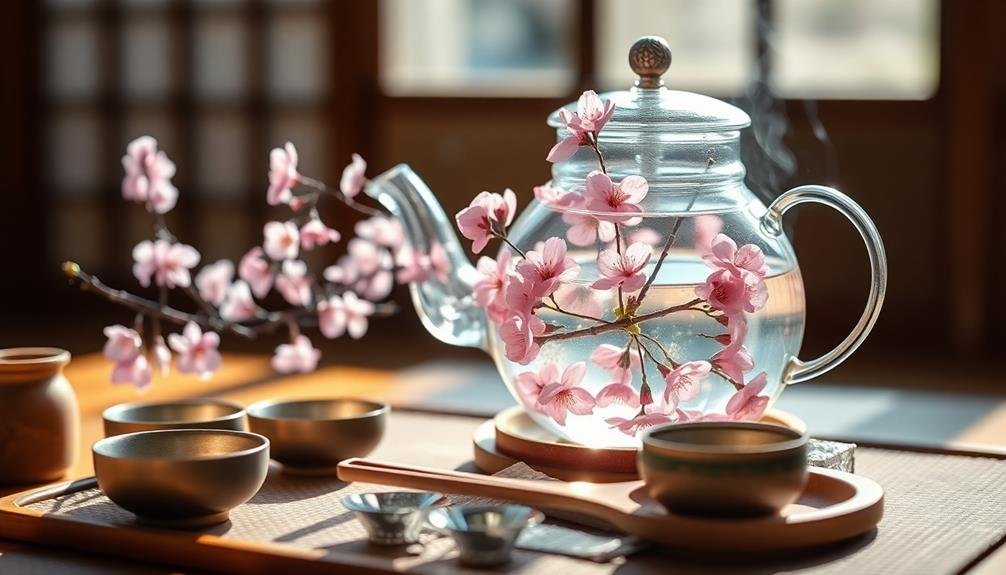
Every spring, fresh cherry blossoms take center stage in traditional Japanese tea ceremonies. These delicate pink flowers, known as sakura in Japan, symbolize renewal and the transient nature of life. You'll find them incorporated into various aspects of the tea ceremony, from the decorative arrangements to the tea itself.
When you attend a spring tea ceremony, you'll likely notice cherry blossom branches adorning the tokonoma, a small alcove in the tea room. The host carefully selects these branches to create a seasonal atmosphere that complements the ceremony's theme.
You'll also encounter cherry blossom-flavored sweets, called wagashi, served alongside the tea. These confections are often shaped to resemble the flowers and provide a subtle, floral taste that pairs well with the bitter matcha.
For a truly immersive experience, some tea masters infuse dried cherry blossoms directly into the tea. This creates a delicate, aromatic brew that captures the essence of spring. The resulting tea offers a unique flavor profile, combining the grassy notes of matcha with the light, sweet fragrance of cherry blossoms.
Summer Chrysanthemum Petals
You'll find chrysanthemum petals to be an invigorating addition to your summer tea ceremonies.
These fragrant blooms offer cooling properties that'll help beat the heat while symbolizing energy and longevity in many cultures.
To prepare, you'll want to gently steep the dried petals in hot water, allowing their subtle floral essence to infuse your tea with the essence of summer.
Cooling Properties
During the sweltering summer months, chrysanthemum petals offer a revitalizing addition to tea ceremonies. These delicate flowers possess natural cooling properties that can help you beat the heat while enjoying your traditional tea ritual. When steeped in hot water, chrysanthemum petals release compounds that create a rejuvenating and slightly sweet flavor, perfect for soothing your palate on a scorching day.
The cooling effects of chrysanthemum tea extend beyond just taste. You'll find that this floral infusion can help regulate your body temperature and provide a sense of relief from the oppressive heat. It's no wonder that chrysanthemum tea has been a staple in traditional Chinese medicine for centuries, valued for its ability to clear heat from the body and promote overall well-being.
To fully appreciate the cooling properties of chrysanthemum petals in your tea ceremony, consider the following:
- Use fresh or dried petals for maximum potency
- Steep for 3-5 minutes to release the best flavor and benefits
- Serve chilled or at room temperature for enhanced cooling effects
Symbolic Summer Meanings
Chrysanthemum petals bring more than just cooling properties to summer tea ceremonies; they carry deep symbolic meanings. In Japanese culture, you'll find that these delicate flowers represent longevity, rejuvenation, and nobility. When you incorporate chrysanthemum petals into your summer tea ritual, you're not only revitalizing your palate but also invoking these powerful symbols.
The golden hues of summer chrysanthemums mirror the sun's brilliance, symbolizing liveliness and the season's abundant energy. As you sip your tea, you're connecting with the essence of summer itself.
In Chinese tradition, chrysanthemums are one of the "Four Gentlemen" of flowers, embodying integrity and moral fortitude. By including them in your ceremony, you're honoring these virtues.
Moreover, chrysanthemums represent the ninth month in the Chinese calendar, bridging summer and autumn. This shift symbolizes the cyclical nature of life and the wisdom gained through changing seasons.
As you experience the subtle flavors of chrysanthemum-infused tea, you're partaking in a centuries-old practice that celebrates the fleeting beauty of summer and the profound lessons it imparts.
Preparation and Steeping
To harness the symbolic power of chrysanthemums in your summer tea ceremony, proper preparation is key. Begin by selecting fresh, organic chrysanthemum petals, preferably white or yellow varieties. Gently rinse the petals in cool water to remove any debris, then pat them dry with a clean cloth.
For the steeping process, you'll need:
- A clear glass teapot
- Filtered water
- A thermometer
Heat the water to 185°F (85°C), as this temperature will extract the delicate flavors without bitter notes. Place a small handful of petals in the teapot and pour the hot water over them. Allow the tea to steep for 3-5 minutes, depending on your desired strength.
As you prepare the tea, focus on the chrysanthemum's symbolism of longevity and optimism. The clear teapot allows you to observe the petals unfurling, enhancing the visual aspect of the ceremony.
Strain the tea into cups, and you'll notice a light, golden hue. The resulting infusion offers a subtle, floral taste with a hint of sweetness. Serve immediately to capture the essence of summer in each sip.
Autumn Roasted Chestnuts

Autumn's arrival brings the comforting aroma of roasted chestnuts to tea ceremonies. You'll find these seasonal delicacies paired with various teas, enhancing the overall experience. Chestnuts are harvested in late September through November, making them a perfect autumn addition.
To prepare chestnuts for your tea ceremony, you'll need to roast them first. Score an "X" on the flat side of each chestnut, then roast them in a 425°F oven for about 25 minutes. Once cooled, peel off the shells and inner skin. You can serve them whole or chopped alongside your tea.
Roasted chestnuts complement many autumn-inspired teas. Try pairing them with a robust oolong or a warming genmaicha. Their slightly sweet, nutty flavor balances well with the earthy notes of these teas. For a more indulgent experience, combine them with a chestnut-flavored black tea.
When presenting roasted chestnuts at your tea ceremony, use a small wooden bowl or plate to maintain a natural, seasonal aesthetic. Offer them as a snack between tea servings or as a finishing touch to your ceremony.
Their warmth and aroma will create a cozy atmosphere, perfect for autumn gatherings.
Winter Dried Citrus Peel
Winter's chill brings a new seasonal ingredient to tea ceremonies: dried citrus peel. You'll find this aromatic addition adds a zesty touch to your winter tea rituals. Traditionally, citrus peels are dried in the sun or by a fire, concentrating their flavors and preserving them for use throughout the cold months.
When preparing dried citrus peel for your tea ceremony, you'll want to choose high-quality, organic fruit. The most common varieties used are:
- Yuzu: A Japanese citrus with a complex, tart flavor
- Mandarin orange: Sweet and fragrant, perfect for balancing bitter teas
- Pomelo: Large and mild, with a subtle grapefruit-like taste
To incorporate dried citrus peel into your tea, simply add a small piece to your teapot or cup. As it steeps, it'll release its oils, infusing your brew with a bright, uplifting aroma.
You can also grind the peel into a fine powder and sprinkle it on top of your tea for a more intense flavor. Dried citrus peel pairs exceptionally well with green and oolong teas, adding a revitalizing twist to these traditional winter warmers.
Seasonal Wild Mountain Herbs
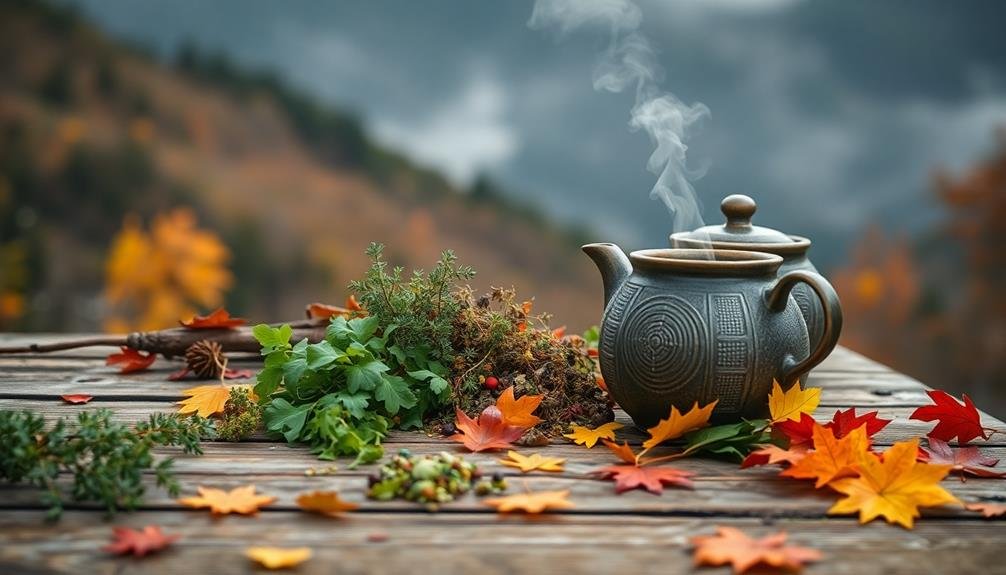
Mountain slopes and hidden valleys burst with seasonal wild herbs, each offering unique flavors to elevate your tea ceremony.
In spring, you'll find tender shoots of wild mint and lemon balm, perfect for adding a revitalizing twist to green teas. Look for delicate violets and primrose blossoms to infuse a subtle floral note.
Summer brings an abundance of wild thyme, oregano, and chamomile. These aromatic herbs pair wonderfully with light oolong teas, creating a soothing and fragrant brew.
Don't overlook the pungent wild garlic leaves, which can add an unexpected savory dimension to your tea blend.
As autumn approaches, you'll discover wild rosehips and elderberries. These tart fruits can be dried and used to add a rich, fruity flavor to black teas.
Forage for yarrow and goldenrod to introduce earthy, slightly bitter notes that complement robust teas.
In winter, seek out evergreen needles from pine or spruce trees. They'll impart a crisp, resinous flavor that's particularly invigorating when paired with bold black teas.
Remember to always harvest responsibly and be certain of your identification before using any wild herbs in your tea ceremonies.
Fragrant Pine Needles
You'll find that fragrant pine needles offer a unique addition to your tea ceremony repertoire.
When harvesting, select young, bright green needles from the tips of branches, then gently rinse and dry them before use.
These aromatic needles symbolize longevity and resilience in many cultures, pairing well with green teas to create a revitalizing, forest-inspired brew.
Harvesting and Preparation Techniques
While many overlook pine needles as a tea ingredient, they offer a delightful, aromatic addition to seasonal ceremonies when properly harvested and prepared. To guarantee the best quality, you'll want to gather pine needles from young, vibrant trees in the early spring or late fall. Look for bright green needles that are free from discoloration or damage.
It's essential to harvest sustainably, taking only a small amount from each branch to protect the tree's health.
Once you've collected your pine needles, rinse them thoroughly in cool water to remove any dirt or debris. Pat them dry gently with a clean cloth, then chop them into small pieces to release their essential oils.
To prepare the tea, you can either steep the needles in hot water for 10-15 minutes or gently simmer them for a stronger flavor.
Here are some key benefits of pine needle tea:
- Rich in vitamin C and antioxidants
- Provides a natural boost to the immune system
- Offers a unique, invigorating taste that complements traditional tea ceremonies
Remember to always identify the pine species before harvesting, as some varieties can be toxic.
With proper care and preparation, pine needle tea can become a cherished addition to your seasonal tea ceremonies.
Symbolic Meanings and Traditions
In many cultures, fragrant pine needles hold deep symbolic meanings and play important roles in traditional ceremonies. When you incorporate pine needles into your tea ceremony, you're tapping into a rich history of symbolism and tradition.
Pine needles represent longevity, wisdom, and resilience. In East Asian cultures, they're often associated with winter and the ability to withstand harsh conditions. You'll find them used in various rituals throughout the year, particularly during the winter solstice and New Year celebrations.
Here's a quick overview of pine needle symbolism in different cultures:
| Culture | Symbolic Meaning | Traditional Use | Season |
|---|---|---|---|
| Chinese | Longevity and steadfastness | New Year decorations | Winter |
| Japanese | Purity and renewal | Tea ceremony ingredient | Year-round |
| Korean | Protection and good fortune | Medicinal teas | Winter |
| Native American | Cleansing and healing | Smudging ceremonies | Year-round |
When you use pine needles in your tea ceremony, you're not just adding flavor and aroma. You're connecting with ancient traditions and inviting positive energy into your space. The act of brewing and serving pine needle tea becomes a mindful practice, encouraging reflection and appreciation for nature's gifts.
Flavor Profile and Pairings
Pine needles bring a unique flavor profile to tea ceremonies, standing out with their invigorating and slightly resinous taste. You'll find that their essence imparts a revitalizing, forest-like quality to your tea, creating a sensory experience that transports you to a serene woodland setting.
The crisp, clean notes of pine complement a variety of tea bases, particularly green and white teas, enhancing their natural, earthy flavors.
When pairing pine needle tea with other ingredients, consider these complementary flavors:
- Citrus fruits like lemon or orange to brighten the piney notes
- Honey or maple syrup to balance the slight bitterness
- Mint or rosemary for an added layer of herbal complexity
You can also experiment with blending pine needles with different tea varieties. Try incorporating them into a robust black tea for a bold, wintery brew, or mix them with chamomile for a soothing, aromatic evening drink.
Remember that pine's distinct flavor can easily overpower more delicate teas, so start with a small amount and adjust to your taste preferences. By carefully balancing the pine needle's unique profile, you'll create a memorable and harmonious tea experience.
Harvested Young Tea Leaves

Countless tea connoisseurs enthusiastically anticipate the arrival of freshly harvested young tea leaves each season. These tender shoots, often called "first flush," offer a unique flavor profile that's prized in traditional tea ceremonies. You'll find that young leaves are typically harvested in spring, when the plants awaken from winter dormancy.
The quality of young tea leaves depends on several factors:
| Factor | Importance | Impact on Flavor |
|---|---|---|
| Timing | Critical | Guarantees peak flavor |
| Climate | High | Affects growth rate |
| Soil | Moderate | Influences mineral content |
| Harvesting Method | High | Preserves leaf integrity |
When selecting young tea leaves for your ceremony, you'll want to take into account their origin and processing method. Japanese gyokuro, for instance, is shaded before harvest to enhance its umami flavor. Chinese dragon well tea, on the other hand, is pan-fired to stop oxidation, resulting in a distinctive chestnut-like taste.
You'll notice that young tea leaves often produce a lighter, more delicate brew compared to mature leaves. This subtlety makes them ideal for showcasing the nuances of different tea varieties in your ceremonies.
Local Honey
You'll find that local honey adds a unique twist to your tea ceremony.
Its floral flavor profiles can complement various teas, enhancing their natural taste notes.
Beyond flavor, local honey offers nutritional benefits, including antioxidants and potential allergy-fighting properties, making it a valuable addition to your tea ritual.
Floral Flavor Profiles
While honey is often associated with sweetness, local varieties can introduce complex floral notes to your tea ceremony. The flavor profile of honey depends on the flowers the bees visit, resulting in a diverse range of tastes and aromas.
You'll find that different types of honey can complement various teas, enhancing their natural flavors and creating unique sensory experiences.
When selecting honey for your tea ceremony, consider the following floral profiles:
- Lavender honey: Offers a delicate, herbal sweetness that pairs well with light green teas
- Orange blossom honey: Provides a citrusy undertone, perfect for black teas or Earl Grey
- Wildflower honey: Presents a complex mix of floral notes, ideal for oolong or white teas
To fully appreciate the floral nuances, warm the honey slightly before adding it to your tea. This will help release its aromatic compounds and blend more smoothly with the hot liquid.
You can also experiment with different honey-to-tea ratios to find the perfect balance of sweetness and floral notes. Remember that the goal is to enhance, not overpower, the tea's natural flavors.
Nutritional Benefits
Beyond its delightful taste, local honey offers several nutritional benefits that can enhance your tea ceremony experience. It's packed with antioxidants, enzymes, and minerals that support your overall health. When you incorporate local honey into your tea, you're not just adding sweetness; you're boosting your immune system and promoting better digestion.
Local honey contains trace amounts of pollen from your area, which can help build immunity against seasonal allergies. It's also a natural energy booster, providing a quick and sustainable source of carbohydrates. Unlike refined sugars, honey won't cause a sharp spike in blood sugar levels, making it a healthier sweetening option for your tea.
Here's a quick overview of local honey's nutritional benefits:
| Nutrient | Benefit | Impact on Tea |
|---|---|---|
| Antioxidants | Fight free radicals | Enhance overall health |
| Enzymes | Aid digestion | Improve tea's digestive properties |
| Minerals | Support bodily functions | Complement tea's mineral content |
Edible Flowers
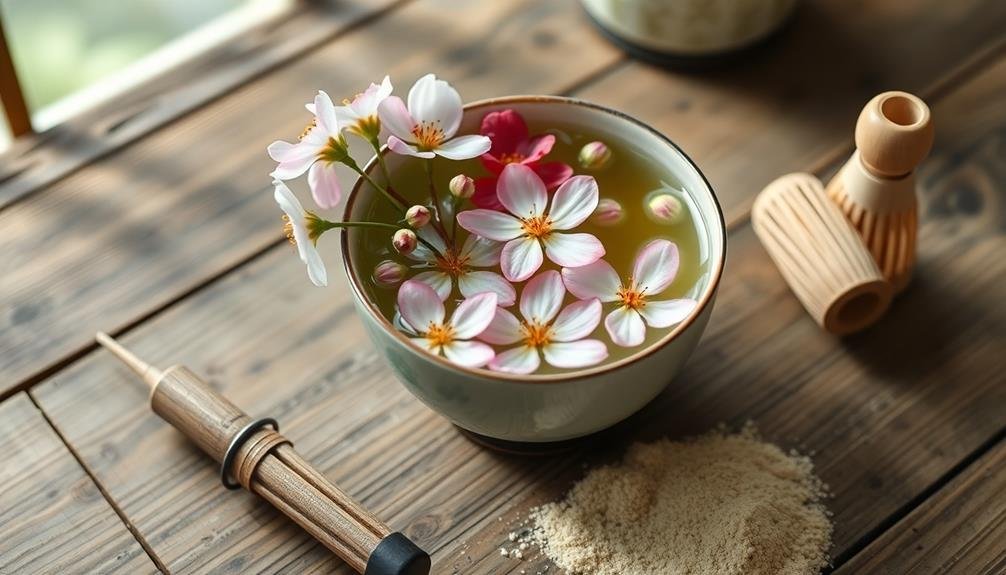
Edible flowers add a delightful touch of elegance and flavor to tea ceremonies. You'll find that incorporating these beautiful blossoms into your tea service can elevate the experience and impress your guests.
When selecting edible flowers, it's essential to choose organic, pesticide-free varieties to guarantee safety and maximum taste.
Some popular edible flowers for tea ceremonies include:
- Chrysanthemum: Known for its sweet, floral flavor and potential health benefits
- Jasmine: Offers a delicate, aromatic taste that pairs well with green teas
- Rose: Provides a subtle, romantic flavor and stunning visual appeal
You can use edible flowers in various ways during your tea ceremony. Try floating them on top of your tea for a visually striking presentation, or infuse them directly into the hot water for a more pronounced flavor.
You can also use them as garnishes on accompanying snacks or sweets.
Remember to introduce edible flowers gradually, as some people may have allergies or sensitivities. Always inform your guests about the flowers you're using and their potential effects.
Foraged Berries
In the domain of seasonal ingredients, foraged berries offer a unique and exciting addition to tea ceremonies. You'll find that incorporating these wild fruits can elevate your tea experience, adding both visual appeal and complex flavors to your brews.
When foraging for berries, it's important to correctly identify safe, edible varieties. Common options include blackberries, raspberries, and elderberries, each bringing its own distinct taste profile. Blackberries offer a rich, slightly tart flavor, while raspberries contribute a delicate sweetness. Elderberries, known for their immune-boosting properties, impart a deep, earthy essence.
To use foraged berries in your tea ceremony, you can add them fresh to hot or cold brews, create berry-infused syrups, or dry them for longer-term storage. Remember to harvest responsibly, taking only what you need and leaving plenty for wildlife and other foragers.
Timing is essential when incorporating foraged berries into your tea ceremonies. You'll want to align your gatherings with the peak ripeness of local berry varieties, typically occurring in late summer to early fall, depending on your region.
Frequently Asked Questions
How Do You Properly Store Seasonal Ingredients for Tea Ceremonies?
You'll want to store your tea ceremony ingredients properly. Keep them in airtight containers, away from light and moisture. Place dried items in a cool, dark place. Refrigerate fresh ingredients and use them quickly for ideal freshness.
What Are the Health Benefits of Using Seasonal Ingredients in Teas?
You'll boost your immune system and get a nutritional punch by using seasonal ingredients in teas. They're packed with fresh vitamins, minerals, and antioxidants. You're also supporting your body's natural rhythms and enjoying peak flavors.
Can Seasonal Ingredients Affect the Caffeine Content of Traditional Teas?
Yes, seasonal ingredients can affect caffeine content in traditional teas. You'll find that some herbs and flowers added to teas may reduce or increase caffeine levels. It's worth noting that caffeine content can vary depending on the season.
Are There Any Seasonal Ingredients to Avoid in Tea Ceremonies?
You should avoid using ingredients that overpower the tea's natural flavor or clash with its aroma. Don't add strongly scented herbs or spices that could disrupt the ceremony's harmony. It's best to stick with subtle, complementary seasonal additions.
How Do You Pair Seasonal Tea Ingredients With Traditional Sweets?
You'll want to match flavors and textures when pairing seasonal tea ingredients with traditional sweets. Consider balancing light teas with delicate sweets and robust teas with richer treats. Don't be afraid to experiment with contrasting flavors, too.
In Summary
You've now explored some of the finest seasonal ingredients to elevate your traditional tea ceremonies. By incorporating these natural elements, you'll create a more authentic and immersive experience. Don't be afraid to experiment with different combinations and proportions. Remember, the changing seasons offer new opportunities to refresh your tea ritual. Embrace the local and seasonal bounty, and you'll discover a deeper connection to nature and the art of tea.

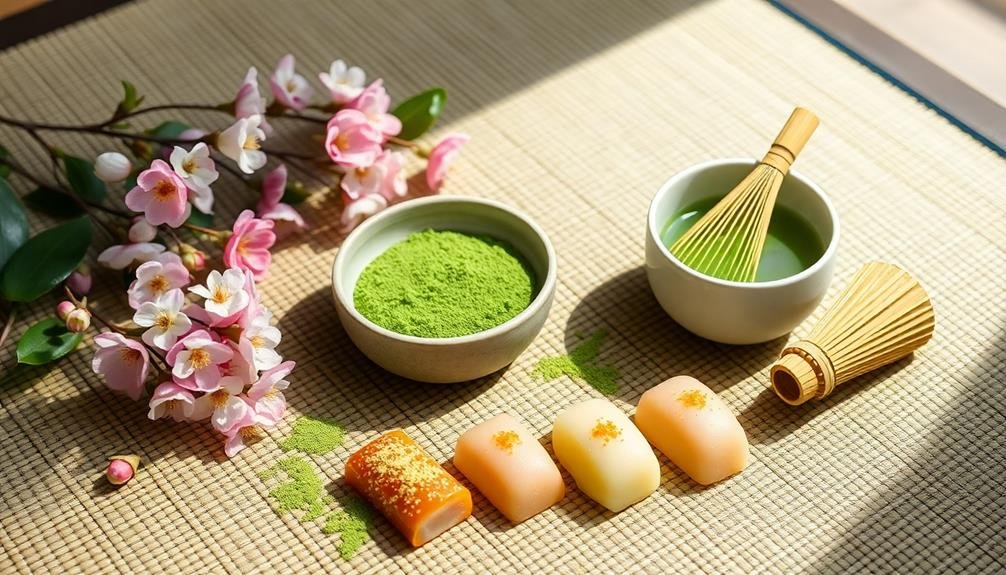
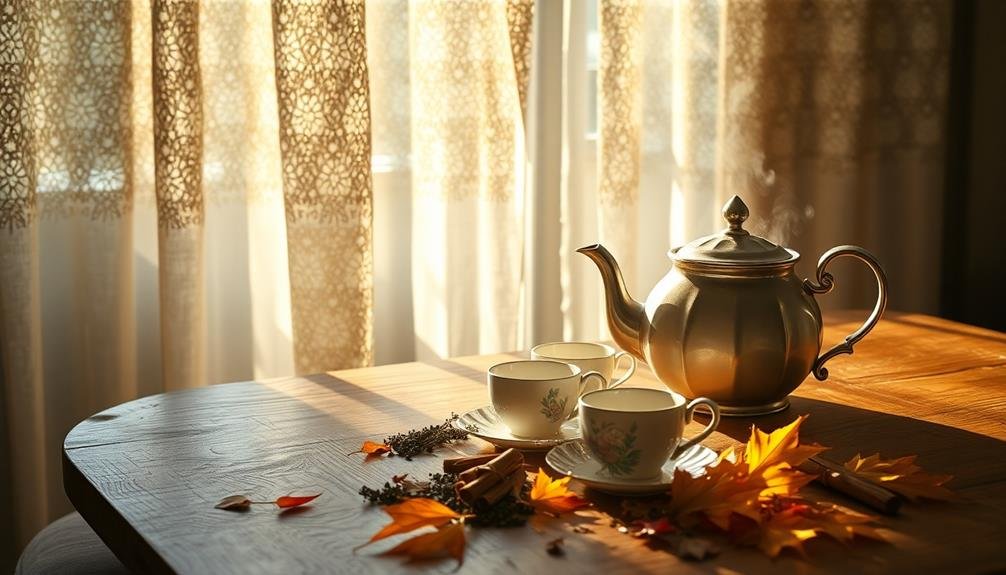
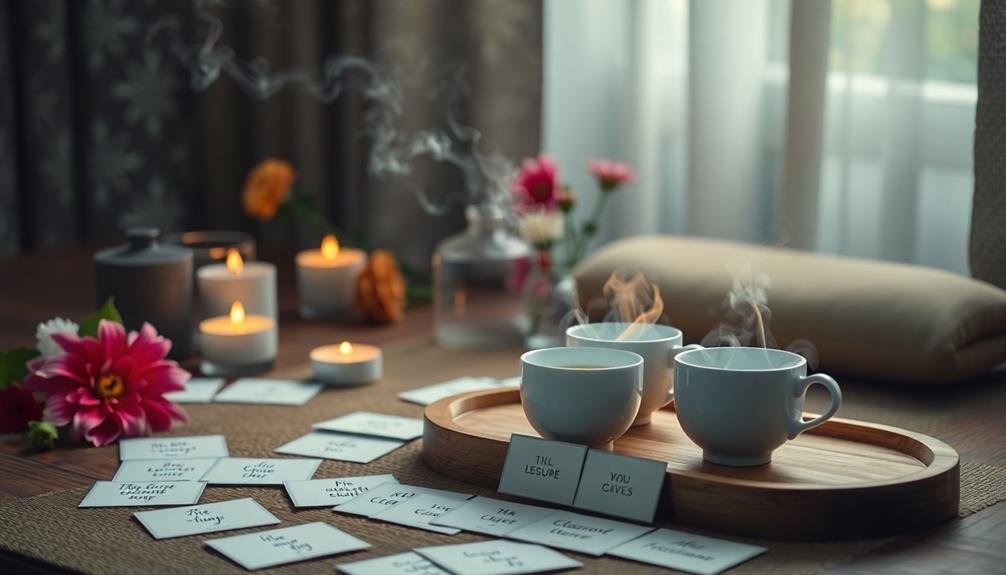
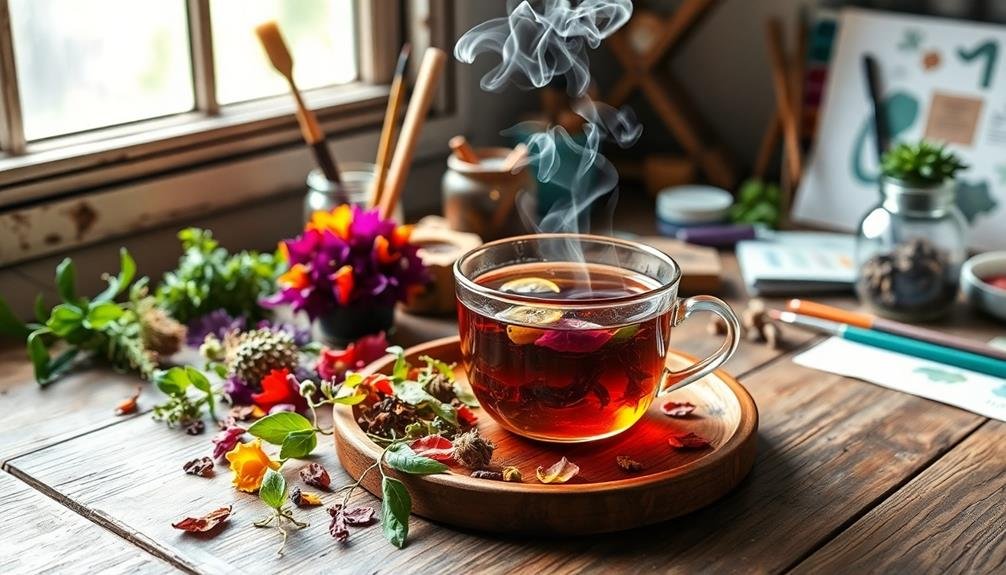
Leave a Reply